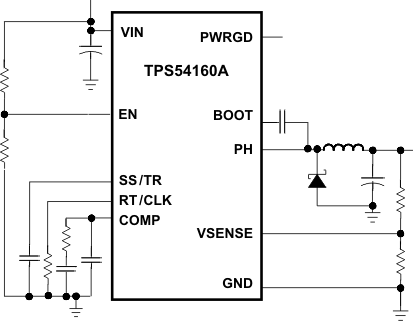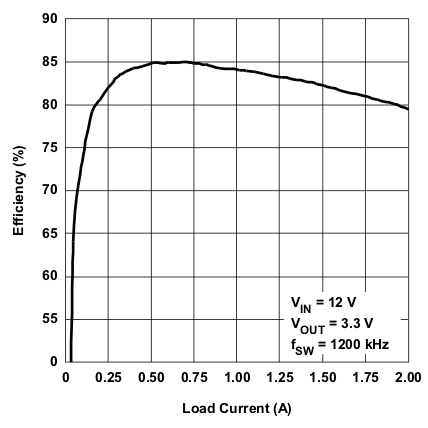SLVSB56C May 2012 – February 2014 TPS54160
PRODUCTION DATA.
- 1 Features
- 2 Applications
- 3 Description
- 4 Simplified Schematic
- 5 Revision History
- 6 Terminal Configuration and Functions
- 7 Specifications
-
8 Detailed Description
- 8.1 Overview
- 8.2 Functional Block Diagram
- 8.3
Feature Description
- 8.3.1 Fixed Frequency PWM Control
- 8.3.2 Slope Compensation Output Current
- 8.3.3 Pulse Skip Eco-mode
- 8.3.4 Bootstrap Voltage (BOOT)
- 8.3.5 Low Dropout Operation
- 8.3.6 Error Amplifier
- 8.3.7 Voltage Reference
- 8.3.8 Adjusting the Output Voltage
- 8.3.9 Enable and Adjusting Undervoltage Lockout
- 8.3.10 Slow Start and Tracking Pin (SS/TR)
- 8.3.11 Overload Recovery Circuit
- 8.3.12 Sequencing
- 8.3.13 Constant Switching Frequency and Timing Resistor (RT/CLK Pin)
- 8.3.14 Overcurrent Protection and Frequency Shift
- 8.3.15 Selecting the Switching Frequency
- 8.3.16 How to Interface to RT/CLK Pin
- 8.3.17 Power Good (PWRGD Pin)
- 8.3.18 Overvoltage Transient Protection
- 8.3.19 Thermal Shutdown
- 8.3.20 Small Signal Model for Loop Response
- 8.3.21 Simple Small Signal Model for Peak Current Mode Control
- 8.3.22 Small Signal Model for Frequency Compensation
- 8.4 Device Functional Modes
-
9 Application and Implementation
- 9.1 Application Information
- 9.2
Typical Application
- 9.2.1 Design Requirements
- 9.2.2
Detailed Design Procedures
- 9.2.2.1 Selecting the Switching Frequency
- 9.2.2.2 Output Inductor Selection (LO)
- 9.2.2.3 Output Capacitor
- 9.2.2.4 Catch Diode
- 9.2.2.5 Input Capacitor
- 9.2.2.6 Slow Start Capacitor
- 9.2.2.7 Bootstrap Capacitor Selection
- 9.2.2.8 Under Voltage Lock Out Set Point
- 9.2.2.9 Output Voltage and Feedback Resistors Selection
- 9.2.2.10 Compensation
- 9.2.2.11 Power Dissipation Estimate
- 9.2.3 Application Curves
- 10Power Supply Recommendations
- 11Layout
- 12Device and Documentation Support
- 13Mechanical, Packaging, and Orderable Information
1 Features
- 3.5 V to 60 V Input Voltage Range
- 200-mΩ High-Side MOSFET
- High Efficiency at Light Loads with a Pulse Skipping Eco-mode™
- TPS54160A has Tighter Enable Threshold Than TPS54160 for More Accurate UVLO voltage
- Adjustable UVLO Voltage and Hysteresis
- 116 μA Operating Quiescent Current
- 1.3 μA Shutdown Current
- 100 kHz to 2.5 MHz Switching Frequency
- Synchronizes to External Clock
- Adjustable Slow Start/Sequencing
- UV and OV Power Good Output
- 0.8-V Internal Voltage Reference
- MSOP10 and 3mm x 3mm VSON Package with PowerPAD™
- Supported by WEBBENCH® and SwitcherPro™ Software Tool
2 Applications
- 12-V, 24-V and 48-V Industrial and Commercial Low Power Systems
- Aftermarket Auto Accessories: Video, GPS, Entertainment
3 Description
The TPS54160A device is a 60-V, 1.5-A, step down regulator with an integrated high-side MOSFET. Current mode control provides simple external compensation and flexible component selection. A low ripple pulse skip mode reduces the no load, regulated output supply current to 116 μA. Using the enable pin, shutdown supply current is reduced to 1.3 μA.
Under voltage lockout is internally set at 2.5 V, but can be increased using the enable pin. The output voltage startup ramp is controlled by the slow start pin that can also be configured for sequencing/tracking. An open drain power good signal indicates the output is within 94% to 107% of its nominal voltage.
A wide switching frequency range allows efficiency and external component size to be optimized. Frequency fold back and thermal shutdown protects the part during an overload condition.
4 Simplified Schematic

4.0.1 Efficiency vs Load Current
